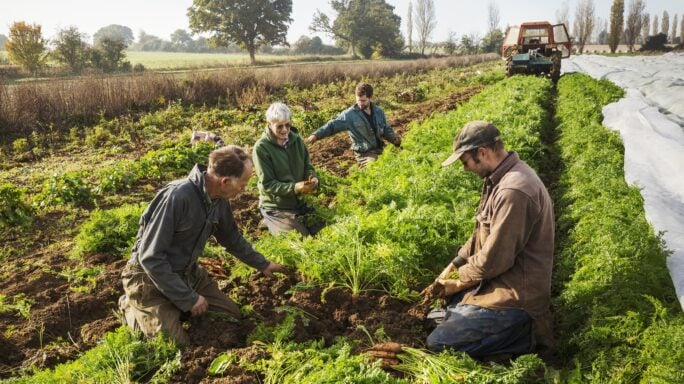Strategy, Legal & Operations
Looking to get your carbon footprint certified? Let’s explore your options

Duncan Oswald CEnv FIEMA, Climate Science Lead at Sage, takes a look at the variety of options businesses have to get their carbon footprint “certified.”
We are often asked if our carbon footprints are certified. Like many simple questions in this field, this one doesn’t have a simple answer but, if you like that sort of thing, trying to answer it is interesting.
There are lots of ways to certify a carbon footprint, and they vary in quality and cost.
Full ISO audit: The gold standard
The best is certification to ISO 14064-1:2018, “Greenhouse gasses – Part 1: Specification with guidance at the organization level for quantification and reporting of greenhouse gas emissions and removals.” This can only be done by an auditor who is qualified and accredited by the United Kingdom Accreditation Service (UKAS), or equivalent in other jurisdictions.
These auditors are not only trained in the requirements of the standard, they also have broader environmental qualifications, so they understand what they are looking at: they can see not only what is under their noses, but also what isn’t, but should be. Qualified auditors are few and far between, so you may struggle to find anyone to do it, and it costs several thousand pounds, every year.
This is the route taken by major multinationals with deep pockets, who want to prove that their footprint is as good as it gets. It is not generally appropriate for small businesses.
PAS 2050: A balanced approach
The next best option is to use an internationally recognised structure, such as PAS 2050:2011, “Specification for the assessment of the life cycle greenhouse gas emissions of goods and services.” A PAS is a “Publicly Accessible Specification:” it sets out requirements for conformity, but you can’t certify anything to a PAS; the best you can do is to “verify.” This might sound like splitting hairs, but the difference is important: you can verify your own footprint, or hire a consultant to work on a footprint and then verify it themselves.
There is no requirement for competence or independence, as there is with certification. PAS 2050 (and its siblings, 2060, 2070 and 2080) is a comprehensive and rigorous structure and is highly recommended, but the ability to “mark your own homework” undermines its reliability as a certification.
Proprietary badges: Who do you trust?
Below the PAS family, there is a whole ecosystem of proprietary badges; many of which are backed by reputable organisations. The Carbon Trust standard is perhaps the best known (although it has recently been replaced by the “Route to Net Zero” standard).
These standards may well be great, but as they are proprietary, their content and structure are secret, so it’s hard to tell. Also, they can only be awarded by the organisations that developed them, not only marking their own homework but also setting it, and not telling the teacher what it was. Again, not great for building trust; you are relying on the reputation of the organisation which issues the badge.
Limited assurance: Does what it says—gives limited assurance
You may also hear of environmental declarations (such as carbon footprints) being audited to ISAE 3410. This is an assurance (not certification) standard which comes from the world of accounting. It has in 2 levels: reasonable and limited. Reasonable assurance—under ISAE3410—requires that an auditor reviews the application of the calculation methodology used to inform the declaration, rigorously enough that they can sign a statement that it has been applied as stated. Limited assurance however, requires only that they state that they have not found any evidence that it has not.
These auditors do not need any knowledge of what they are looking at. They don’t need to understand, or even check the underlying assumptions. They don’t even need to check that the calculation methodology is reasonable. All they have to do is state that the sums have been done in the way the reporting company said they were done (or at least, that they have not found any evidence to the contrary). Our methodology is automated, so it cannot be applied incorrectly. It’s hard to see what value ISAE 3410 assurance could add.
GHG Protocol: The foundations
Fortunately, all carbon footprinting is based on the Greenhouse Gas Protocol. This provides the underlying boundaries, definitions, and the now famous scopes 1, 2, and 3. The GHG Protocol is not a certification system, but because it underpins everything in the world of emissions reporting, it is the foundation for all the published standards (and probably the proprietary ones), and for disclosure platforms such as B-Corp, CDP, and the Science Based Targets Initiative (SBTi). These are again self-certified: disclosing organisations declare that the submitted figures have been calculated correctly, but it is not necessary to have a qualified auditor certify that this is true. These platforms demonstrate a business’s commitment to sustainability, and the Sage Earth platform is ideal for delivering the climate element of this.
The Sage Earth approach: Transparency
So where does that leave Sage Earth certification? Well, you can’t certify a methodology. You can’t even verify it. It is perfectly possible to audit a carbon footprint generated by the Sage Earth methodology using any of the schemes mentioned above (any of the published schemes anyway; nobody knows what the requirements of the proprietary schemes are, other than the scheme owners themselves). So, you could generate a footprint on Sage Earth, then pay a consultant to audit it to ISO14064-1, or PAS 2050 and gain certification (or verification) that way. But the certification would only apply to that specific carbon footprint.
This approach is expensive too, and most of our users are small businesses. The whole point of the platform is to make accurate carbon footprinting accessible, so this is not really a viable route.
For now, what we do is publish as much as we can of our underlying data and calculation methodology, keeping everything as transparent as possible, so users and other stakeholders can see how it works. We continue to assess the methodology against the standards, to ensure that it would pass an audit, and if any user wants to get their footprint audited, we will gladly support them, but the short answer is “no, they are not certified but, with very few exceptions, nor are any others.”
Summary
As promised, not a simple answer. How you go about certifying (or verifying) your carbon footprint depends on several factors, including budget, resources, commitment, and motivation. In many ways, being transparent about your decarbonisation programme is best, but in some contexts (e.g. supply chain emissions), your stakeholders don’t have time to read long-form explanations; they just need to see a badge they can trust.
As the only badge that is completely trustworthy is an ISO certificate, which is beyond the budget of most businesses, the approach we take is to be as transparent as possible about our methodology, so that auditors can check it, and to automate as much of the footprinting process as possible, making it easier to complete well and harder to do badly.

Did you know that Sage has a new Carbon Accounting software solution?
If you use either Sage Business Cloud Accounting or Sage 50, Sage Earth can help you better understand your business's environmental impact and guide you to net zero emissions.








Ask the author a question or share your advice